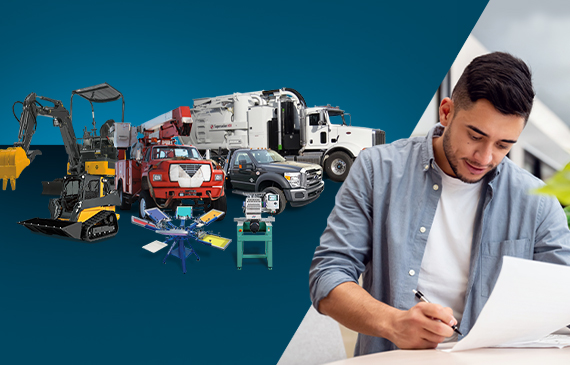Tax season approaches faster than you might think, and for business owners, it’s crucial to maximize tax benefits.
What many businesses don’t realize is that they can actually save on their income taxes by financing equipment that qualifies for deductions. When you utilize Section 179 of the tax code, it’s not just about saving money – it’s also a way to decrease the overall costs of the equipment you need to operate and expand your business.
In this article…
- How Much Could You Save on Your 2024 Income Tax Return?*
- Two Types of Equipment Financing Options
- Maximizing Benefits with the Section 179 Deduction
How Much Can You Save On Your 2024 Income Taxes?
Whether you leased or financed, learning how to utilize every available tax break can accelerate the success of your small business. See a breakdown of your potential tax savings of two different $55,000 equipment purchase scenarios.
|
Type of Agreement
|
Operating Lease
|
Capital Lease
|
|
Tax Write-Off
|
Deduct Lease Payments: Monthly payments may be deductible during the life of the lease.
|
Section 179 Depreciation: 100% of the equipment may be deductible in the tax year it's acquired. Expense up to $1,220,000 of equipment acquired in 2024.
|
|
Tax Savings Example
|
|
|
|
Lease Structure
|
$55,000 worth of equipment on a 36-month lease with FMV 10% purchase option.
|
$55,000 worth of equipment on a 36-month lease with $1 buyout.
|
|
Monthly Payment
|
$1,632/month
|
$1,838/month
|
|
Projected 2024 Tax Savings
(Assuming 35% Tax Bracket)
|
$6,854
([$1,632 x 12 months] x 35 percent)
|
$19,250
($55,000 x 35 percent)
|
|
Projected 2025 Tax Savings
(Assuming 35% Tax Bracket)
|
$6,854
([$1,484 x 12 months] x 35 percent)
|
$0
|
|
Projected 2026 Tax Savings
(Assuming 35% Tax Bracket)
|
$6,854
([$1,484 x 12 months] x 35 percent)
|
$0
|
|
Projected Total Tax Savings
|
$20,562
|
$19,250
|
* All examples provided herein are for illustrative purposes only. Actual numbers will vary based on tax brackets, lease payment amount, and individual financial institutions.
Be Sure to Get Professional Advice
If you acquired equipment in 2024, remember to discuss your write-off options with your certified public accountant (CPA) or tax advisor. We cannot provide you with specific tax information for your business. Please contact a tax professional for more information.
Calculate Your Capital Lease’s Potential Section 179 Tax Savings
See your potential tax savings now by downloading Beacon Funding's mobile app. It's as easy as a few clicks!
Two Types of Equipment Financing Options
Capital Lease
A capital lease is like a contract that grants you ownership of an asset. From an accounting standpoint, this lease is treated as if you outright own an asset, and it’s recorded on your financial statements accordingly.
This is crucial because the IRS requires you to own the property in order to use depreciation as a deduction. The good news is, if you have a capital lease, such as an Equipment Financing Agreement (EFA) or a lease with a $1 buy-out option, you’re able to claim depreciation over the useful life of the asset.
Quick tip: If you’re utilizing a capital lease, have a chat with your tax advisor about optimizing your tax deduction through Section 179. You could potentially write-off the entire purchase price in the same tax year you acquire the equipment.
Operating Lease
An operating lease is more like a rental agreement that allows you to use an asset without actually owning it. This type of lease often comes with options for a fair market value purchase or a fixed purchase amount, typically around 10% of the equipment’s cost.

Since the equipment remains under the ownership of the lessor (the company providing the lease), businesses can’t claim depreciation on it. However, there’s still a tax advantage – an operating lease is usually considered a rental expense, making it eligible for certain incentives. This means you may be able to write off the lease payments.
Quick tip: Operating leases fall into the category of “true tax leases.” Consult your advisor to determine how much you can save through write-offs on your lease payments.
In essence, by choosing the right type of equipment financing and understanding how tax deductions apply, you’re not just investing in your business’s growth but also making the most of potential tax savings.
Contact your tax professional
Remember, it’s always a smart move to collaborate with your tax advisor to ensure you’re taking full advantage of these opportunities.
Maximizing Benefits with the Section 179 Deduction
The Section 179 deduction offers a valuable advantage to businesses seeking to optimize their tax benefits. Think of Section 179 as a special part of the IRS tax code that allows businesses to deduct the full cost of their equipment in the very year they make the purchase. This presents a substantial money-saving opportunity compared to the traditional method of depreciation.

When you utilize Section 179, you gain the ability to deduct the entire cost of your equipment right away. Typically, these costs would be spread out and accounted for over several years through depreciation. This provision exists to incentivize businesses to invest more in their operations by acquiring modern equipment that can enhance efficiency and fuel growth.
For example…
Let’s say you’re planning to acquire a skid steer for your business. Under normal circumstances, you’d have to allocate a portion of the equipment’s upfront cost over the years based on depreciation rules. But with Section 179, you can immediately deduct a substantial portion of the cost in the same year of purchase.
This means you can avoid the hassle of monitoring depreciation over time.
While Section 179’s impact on vehicle write-offs is somewhat limited, its significance remains high. Whether you’re considering machinery, vehicles, or office equipment, small business owners should grasp the importance of deducting costs in the same year they are incurred.
CALCULATE HOW MUCH I CAN DEDUCT
Moreover, the Section 179 deduction isn’t limited to just new equipment – used equipment qualifies too, as long as it wasn’t previously owned by your business. What’s more, business owners have the flexibility to either purchase equipment outright, or opt for financing/leasing, all while remaining eligible for this valuable tax deduction. This flexibility ensures that businesses can make the best financial decisions while still reaping the benefits of immediate deductions.
In essence, by capitalizing on the Section 179 deduction, business can make strategic financial choices that not only save money but also foster growth and operational efficiency. It’s a tool designed to empower businesses to invest in the future, and it’s worth discussing with your tax advisor to fully unlock its potential for your specific situation.